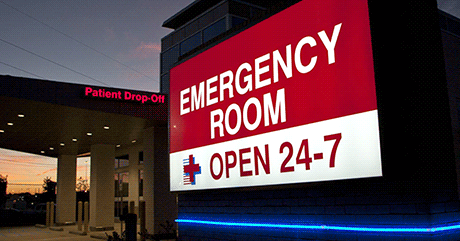Freestanding Emergency Rooms and Ambulance Billing – Part II
Our Thanks!
Welcome to Part II of our series “Freestanding Emergency Rooms and Ambulance Billing.” Our blog posts, this week and last week, is presented thanks to timely reminders passed onto us by Doug Wolfberg of Page, Wolfberg and Wirth. Doug spent the day with our billing office last week providing excellent discussions to help all of us maintain our Certified Ambulance Coder (CAC) certifications via the National Academy of Ambulance Coding (NAAC).
We thank Doug for his presentation which sparked us to pass along the information in this space.
Transporting from a Freestanding ER
One of the unique things about a Freestanding ER is the fact that it is not connected to any inpatient facility and thus when a patient requires further care, the patient must be taken from the Freestanding ER to an inpatient facility.
 You’ll recall from last week’s blog that there are two types of Freestanding ER locations- Non-Facility and Provider Based.
You’ll recall from last week’s blog that there are two types of Freestanding ER locations- Non-Facility and Provider Based.
Non-Facility Freestanding ER locations are considered physician’s offices or the urgent care type facilities.
Provider Based Freestanding ER locations meet the criteria presented by the Centers for Medicare and Medicaid Services (CMS) and the owners of the Freestanding ER have completed a provider based attestation which is on file with CMS.
Usually Billable
Let’s say you receive an ambulance transport request to transport a Medicare beneficiary patient from a Non-Facility Freestanding ER (physician’s office, urgent care, etc.) to an acute care inpatient hospital for further treatment to be admitted. Assuming that your assessment of the patient finds that the patient meets medical necessity and all of the typical coverage criteria are met, this type of transport is usually billable to Medicare Part B.
That’s pretty simple.
3-Part Test
But, let’s say you received an ambulance transport request to transport a Medicare beneficiary patient from a Provider Based Freestanding ER to an inpatient facility. Here’s where things get interesting.
But…there’s an answer and it’s known as the “3-Part Test”. This test applies whenever the origin and destination are both providers…origin is a Provider Based Freestanding ER and the destination is a hospital.
Part One-Provider Numbers
Part one of the 3-Part Test involves determining if the Freestanding ER and the receiving hospital have the same Medicare provider number or different provider numbers. If the two locations have different provider numbers then the transport from the Freestanding ER facility to the hospital facility is billable to Medicare Part B.
But, if the first facility and the second facility have the same provider number then we move on to Part Two.
Part Two-Campus Location
This part of the test involves the location involves the location of the first facility in reference to the physical location the receiving facility. If both facilities have the same Medicare provider number and both facilities are on the same campus then the hospital, not Medicare Part B, is to be billed. According to CMS rules, if the main hospital, nearby buildings- all areas and structures lie within 250 yards of the main building then they are on the same campus and Medicare Part B cannot be billed for the transport.
But…if the sending facility and the receiving hospital are on different campuses then the test moves onto Part Three.
Part Three-Inpatient vs. Outpatient
Okay, your EMS agency has been requested to transport a patient from a Freestanding ER that has the same Medicare provider number as the receiving hospital does. The two facilities are not on the same campus so you’ve cleared Part Two of the 3-Part Test.
Now, to determine who to bill, you must first find out for your billing office if the patient is considered an inpatient at both the Freestanding ER and the receiving hospital. Inpatient status is determined by when the admission is ordered by the admitting physician. If the physician or other healthcare practitioner responsible for the patient’s care is responsible for deciding if the patient should be admitted as an inpatient and was already considered an inpatient upon picking up the patient then the resulting bill goes to the hospital and not to Medicare Part B (and by extension most likely other insurance payers.)
Another way to find out who to bill is to learn, prior to billing the claim, if the hospital is billing their bill as an inpatient bundle bill (ambulance bills hospital) or outpatient billing by service (ambulance bills Medicare Part B.)
However, every other combination (same provider number/different campuses) are billable to Medicare Part B. These combinations are Outpatient-to-Inpatient, Inpatient-to-Outpatient, Outpatient-to-Outpatient.